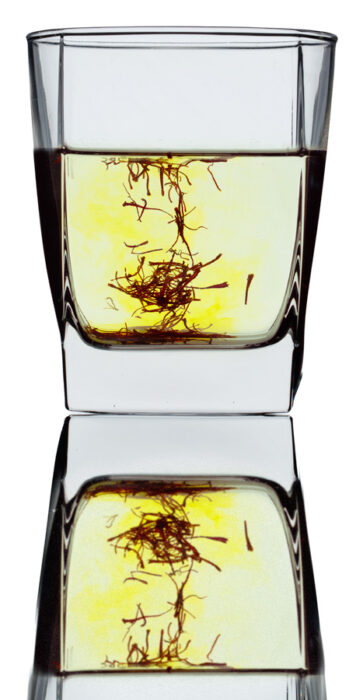Boomify Your Homemade Mayonnaise By Infusing It with Flavor
The only legitimate knock against mayonnaise is that it’s bland. That’s true of commercial mayonnaise, and it’s true of homemade mayonnaise. But it doesn’t have to be that way.
The two dominant ingredients in mayonnaise (water and a neutral oil) have no flavor, yet they make up well over 90 percent of the sauce. What’s left – a little acid, some salt, and in most preparations a dollop of mustard – are diluted by the oil and water to such an extreme they’re just hints of flavor in the background.
But mayonnaise doesn’t have to be bland. Although it can be a challenge to pull off, mayo is a canvas available for adding any of a vast array of flavorings. The sauce then contributes not only the rich and creamy smoothness that it’s traditionally offered for, it becomes more like other sauces, providing depth and complexity to the flavors of a dish.
This week’s post describes the first of the three basic methods to inject custom flavors into a homemade mayonnaise: Flavoring the water phase of the sauce. Next week we’ll look at using the oil in mayonnaise as a flavor delivery vehicle, and in two weeks we’ll consider the third method: Blending other, flavorful foods directly into the mayonnaise to make it into a hybrid sauce.
Plain old water typically makes up at least twenty percent of any mayonnaise. Beyond the water in the eggs (egg whites are mostly water) and the acid (both vinegar and lemon juice consist almost entirely of water), the sauce needs enough water to coat the millions of oil droplets that make up every cupful of the emulsion. Commercial manufacturers boost the water content closer to 30 percent because water is a lot cheaper than oil.
No matter the exact amount you use, the water component of mayonnaise is an opportunity to add flavor. You just need to choose ingredients whose flavors are soluble in water.
Most of the flavor elements in savory ingredients dissolve into either oil or water. A ingredients have flavors that only release into alcohol. That’s true for some of the flavor compounds in tomatoes, which is why vodka tomato sauces periodically make a splash.
The flavor compounds in vegetables and leafy herbs are for the most part water soluble. The flavors in most spices are more likely to be oil-soluble. Some flavorful ingredients have feet in both camps. Garlic, for example, has compounds soluble in water, and other, similarly flavored compounds that dissolve into oil. That’s why a crushed clove of garlic adds its flavor as quickly to a broth as to a coating of oil in the bottom of a sauté pan.
The simplest way of adding water-based flavorings to what would otherwise be plain water in a mayo recipe is by finding water-based liquids that are already packed with flavor. The vinegar or lemon juice in the recipe could, for example, be swapped out for a different acidic liquid. The main difference between Kewpie-style mayonnaises that dominate the Japanese market from their American cousin is that the former use rice wine vinegar (plus a hefty dash of MSG). Replacing the white vinegar or lemon juice in a batch of mayonnaise with a champagne vinegar or other flavored vinegar gives the final product a different nuance of flavor.
An easy shortcut to injecting water-based flavors is finding liquids whose flavors are already concentrated. The best example I know of is liquid smoke, available in most grocery stores. Regardless of the brand, liquid smoke is a surprisingly tasty seasoning. Adding a teaspoonful of the stuff to the water used in a small batch of mayo transforms the result into an incredible new experience. Tabasco sauce or any of the dizzying number of other hot sauces in the grocery aisle likewise gives an intense boost to plain mayo.
For an even more dramatic flavor addition, the culinary essences from Aftelier are so potent that infusing a batch of mayo requires just a drop or two.
Rather than riding the flavor choices made by others in crafting their water-based liquids available for sale, you can choose your own flavors and infuse them into water at home. The basic method is the same as when making stock or tea. The ingredient can be raw or roasted, and it can be used fresh or dried ahead of time, with the infusion in hot water working just as when brewing tea or steeping coffee.

You can infuse water with literally any ingredient containing water-soluble flavors. But the result will be disappointing unless the ingredient has enough flavor oomph to carry through in the finished mayo. Mild herbs, whether fresh or dried, don’t really do that without getting some rough treatment first.
Anything that can be juiced and have its solids strained off can contribute its flavors while leaving intact the creamy texture of the mayonnaise. Juicing vegetables and tender herbs works, though their juices have a strong, harsh flavor. The act of juicing ruptures the uncooked plant cells, activating enzymes that quickly create powerful flavors. So use raw juices with care.
By contrast, steeping those same herbs or vegetables in water deactivates the enzymes that make their raw juice taste strong. Steeping them in water extracts some of their flavor, but the resulting stock is so mild that it barely nudges the flavor meter in a batch of mayonnaise. To get good results with a cooked stock or broth, roast the meat or vegetables that are its base first, then simmer them in water for an infused stock that’s strong enough for just a few tablespoons’ worth to flavor your mayo. The darker the roasting step, the stronger the flavor.

For today’s batch of mayo I’m using saffron. Its flavor isn’t overpowering, but it’s so distinctive that it easily shines through. Saffron is also the ultimate example of an ingredient whose flavor compounds are soluble in water but not in oil. Added to hot water, saffron threads instantly release most of their flavor and coloring. But when added to oil, saffron gives up neither the dye that it is famous for nor any hint of its flavor.
For this mayo I steeped the saffron with minced lemon grass, which isn’t strong enough to star on its own but as in many other dishes it complements the primary flavoring by working in the background.

The saffron-lemongrass mayonnaise is served here as part of a light, room temperature course: Sous vide coho salmon, asparagus spears and tips, dots of lemon fluid gel with rosemary blossoms, and lemon powder.
Saffron-Lemongrass Mayonnaise Recipe
Makes 1 1/4 cups
1 1/2 c (360 g) water
1 shallot, minced
1 section of lemongrass (3-4 inches long), minced
12 saffron threads
1 T (15 g) lemon juice or 2 t (10 g) white vinegar
1 egg (50 g)
1 t (5 g) Dijon mustard
0.4 g xanthan (optional)
1/8 t (0.8 g) salt
1 c (240 g) neutral oil (like Canola, safflower, or vegetable oil)
Put the minced lemongrass and shallot in a saucepan with the water and simmer, covered, for twenty minutes, refreshing with additional water if the amount in the pan drops to half a cup or so. Add the saffron threads and simmer gently for another 10 minutes or until the liquid is reduced to about half a cup. Strain, pressing on the solids to extract as much liquid as possible (ideally around 1/4 cup).
In the bowl of a stand blender put the lemon juice (or white vinegar), the egg, the mustard, and three tablespoons of the saffron broth.
Combine the salt and xanthan (if using it) together. (Stirring the salt into the xanthan ahead of incorporating them both into a liquid is an easy way to protect against the xanthan clumping.) With the blender running at low speed, sprinkle the salt/xanthan mixture into the liquid.
Turn the blender up to medium speed. Starting very slowly (about a teaspoon of oil at a time) add the oil and let the blender process it into the water-based ingredients, which it will do almost instantly. Continue adding oil slowly at first, then after a few seconds add it more rapidly. The entire addition should take at least 10 seconds, but doesn’t need to be drawn out much beyond that so long as the initial oil is added in small quantities.
If the mayonnaise becomes thicker than you want it before all the oil is incorporated, add a little more saffron broth or, if it’s already all in the mayonnaise, add a little plain water to loosen the mixture as desired.


Like this Recipe? Leave a Comment.
Your email address will not be published.